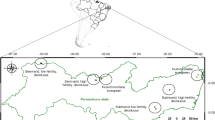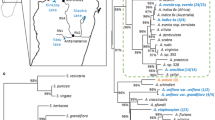Abstract
The north-western Himalayan ranges were surveyed for nodulating legumes that could be useful in tropical afforestation, soil amelioration and reclamation of open cast mine sites, mine spoil heaps, eroded slopes and other denuded ecosystems. Seven new nodulating papilionoid legumes were found and all of them have potential application in revegetation programmes. One new record of a non-nodulating papilionoid member is also reported. The ecological aspects of sampling sites, and habit and root characteristics of the legumes are described. The patterns of nodulation and morphology of nodules are also given. There is a substantial amount of polymorphism in nodule size and shape within a single species as well as among the species; a part of this variation is habitat induced. The nodulation occurs essentially during monsoon season. The remarkable similarity in growth form and nodulation patterns among 7 taxa is the consequence of adaptation to similar ecological conditions.
Similar content being viewed by others
References
Allen O N and Allen E K 1981The Leguminosae (Wisconsin: University of Wisconsin Press)
Babu C R, Nair S, Jha P K, Subramaniam B, Gopinathan M C, Ali A and Mishra K K 1985 Legumes as a source of fuelwood in Himalayan ecosystems;Proc. Bio-Ener. Soc. 1st Conv. Symp. 70–72
Chandler M R 1978 Some observations on infection ofArachis hypogaea L. byRhizobium;J. Exp. Bot. 29 749–755
Chandler M R, Date R A and Roughley R J 1982 Infection and root-nodule development inStylosanthes species byRhizobium;J. Exp. Bot. 33 47–57
Corby H D L 1971 The shape of leguminous nodules and the colour of leguminous roots,Plant Soil (Spl. Vol.) 305–314
Dancer W S, Handley J F and Bradshaw A D 1977 Nitrogen accumulation in Kaolin mining wastes in Cornwell II. Forage legumes;Plant Soil 48 303–314
de Faria S M, Franco A A, de Jesus R M, Menandro M de S, Baitello J B, Mucci E S F, Döbereiner J and Sprent J I 1984 New nodulating legume trees from south-east Brazil;New Phytol. 98 317–328
Haystead A and Marriott C 1978 Fixation and transfer of nitrogen in a white clover-grass sward under hill conditions;Ann. Appl. Biol. 88 453–457
Jeffries R A, Bradshaw A D and Putwain P D 1981a Growth, nitrogen accumulation and nitrogen transfer by legume species established on mine spoil;J. Appl. Ecol. 18 945–956
Jeffries R A, Willson K A and Bradshaw A D 1981b The potential of legumes as a nitrogen source for the reclamation of derelict land;Plant Soil 59 173–177
Author information
Authors and Affiliations
Rights and permissions
About this article
Cite this article
Nair, S., Jha, P.K., Gopinathan, M.C. et al. New nodulating papilionoid legumes of potential value for revegetation of degraded ecosystems. Proc. Indian Acad. Sci. 98, 41–48 (1988). https://doi.org/10.1007/BF03053366
Received:
Revised:
Issue Date:
DOI: https://doi.org/10.1007/BF03053366




